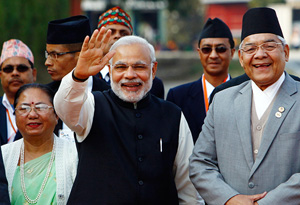Kathmandu, Nov 25: Prime Minister Narendra Modi arrived here today with an aim to inject new momentum to regional bloc SAARC during its two-day summit beginning tomorrow as he said development of close relations with neighbours was a key priority for his government.
On his arrival here to attend his maiden SAARC Summit, Modi was accorded a warm welcome. He was given a guard of honour and a group of girls presented a cultural performance for him.
Modi will articulate India's position on various issues during the summit on November 26-7 and will hold bilateral talks with South Asian heads of state and government on its margins.
While Modi's official programme has no mention of his meeting with Pakistani counterpart Nawaz Sharif, he would be meeting Afghan President Ashraf Ghani, Bangladesh Prime Minister Sheikh Hasina, Sri Lankan President Mahinda Rajapaksa among others.
In his pre-departure statement, Modi said development of close relations with neighbours was a key priority for his government and he was also looking forward to holding talks with other South Asian heads of state and government on the margins of the summit.
"Although this is my first SAARC Summit, during the last six months, I have interacted extensively with leaders of SAARC countries beginning with their auspicious presence at my swearing-in ceremony. Development of close relations with our neighbours is a key priority for my Government," Modi said.
Noting that the summit's theme was "Deeper Regional Integration for Peace and Prosperity", he said India has always emphasised on the importance of greater regional integration at all levels for the socio-economic development of the South Asian region.
"We have undertaken several initiatives in this regard on bilateral, sub-regional and regional basis, and will continue to do more. We hope that the summit will lead to concrete outcomes, particularly in regard to various initiatives on enhancing connectivity that have been under discussion for a long time," he said.
"This will be my second visit to Nepal within four months, which reflects the importance we attach to our unique and special relations with Nepal. There has been significant progress in the implementation of the decisions taken during my visit to Nepal in August 2014. I look forward to reviewing the progress in our relations with Prime Minister Sushil Koirala and other Nepalese leaders," he added.
Prime Minister Modi's high-level delegation at the summit includes External Affairs Minister Sushma Swaraj, National Security Adviser Ajit Doval, Foreign Secretary Sujatha Singh and a number of senior officials of various ministries.





Comments
Add new comment